
A gas mask is an item of personal protective equipment used to protect the wearer from inhaling airborne pollutants and toxic gases. The mask forms a sealed cover over the nose and mouth, but may also cover the eyes and other vulnerable soft tissues of the face. Most gas masks are also respirators, though the word gas mask is often used to refer to military equipment, the scope used in this article. The gas mask only protects the user from digesting, inhaling, and contact through the eyes. Most combined gas mask filters will last around 8 hours in a biological or chemical situation. Filters against specific chemical agents can last up to 20 hours.

Personal protective equipment (PPE) is protective clothing, helmets, goggles, or other garments or equipment designed to protect the wearer's body from injury or infection. The hazards addressed by protective equipment include physical, electrical, heat, chemical, biohazards, and airborne particulate matter. Protective equipment may be worn for job-related occupational safety and health purposes, as well as for sports and other recreational activities. Protective clothing is applied to traditional categories of clothing, and protective gear applies to items such as pads, guards, shields, or masks, and others. PPE suits can be similar in appearance to a cleanroom suit.

Chemical, biological, radiological, and nuclear defense or Nuclear, biological, and chemical protection is protective measures taken in situations in which chemical, biological, radiological, or nuclear hazards may be present. CBRN defense consists of CBRN passive protection, contamination avoidance, and weapons of mass destruction mitigation.

Avon Protection plc is a British company that specialises in the engineering and manufacturing of respiratory protection equipment for military, law enforcement and fire personnel. Its corporate headquarters are 3 km (1.9 mi) south of Melksham in Wiltshire, England, at the Hampton Park West development. It is listed on the London Stock Exchange.

A respirator is a device designed to protect the wearer from inhaling hazardous atmospheres including fumes, vapours, gases and particulate matter such as dusts and airborne pathogens such as viruses. There are two main categories of respirators: the air-purifying respirator, in which respirable air is obtained by filtering a contaminated atmosphere, and the air-supplied respirator, in which an alternate supply of breathable air is delivered. Within each category, different techniques are employed to reduce or eliminate noxious airborne contaminants.
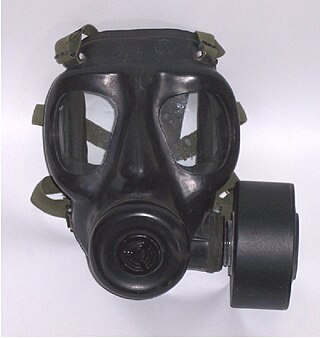
The Service Respirator No. 6 (S6), also known as Respirator NBC S6 No. 1 Mark 1 was a protective gas mask issued to the British Armed Forces. It was developed in the 1950s and issued for general service from 1966 to 1986, when it was replaced by the S10. Currently, the S6 is not used by the British military.

Escape breathing apparatus, also called escape respirators, escape sets, self-rescuer masks, emergency life saving apparatus (ELSA), emergency escape breathing devices (EEBD), and Respiratory Protective Smoke Escape Devices (RPED), are portable breathing apparatus that provide the wearer with respiratory protection for a limited period, intended for escape from or through an environment where there is no breathable ambient atmosphere. This includes escape through water and in areas containing harmful gases or fumes or other atmospheres immediately dangerous to life or health (IDLH).

The Defence Chemical, Biological, Radiological and Nuclear Centre is a United Kingdom military facility at Winterbourne Gunner in Wiltshire, south of Porton Down and about 4 miles (6 km) north-east of Salisbury. It is a tri-service location, with the Army being the lead service. The centre is responsible for all training issues relating to chemical, biological, radiological and nuclear (CBRN) defence and warfare for the UK's armed forces.
The C4 CBRN Protective Mask is the current issued gas mask of the Canadian Armed Forces. The C4 is a negative-pressure, full-face respirator with an ergonomic butyl rubber face piece. With its stretch-fabric mesh head harness and two simple adjustment pull straps, the C4 respirator is easily donned and doffed.
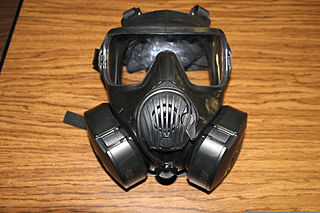
The M50 series protective mask, officially known as the Joint Service General Purpose Mask, is a lightweight, protective mask system consisting of the mask, a mask carrier, and additional accessories. It was adopted by the U.S. military in 2006 and is manufactured by Avon Rubber, the rubber-producing department of Avon Protection. There are two variants, the M50, for ground and shipboard use, and the M51, for ground vehicle use.
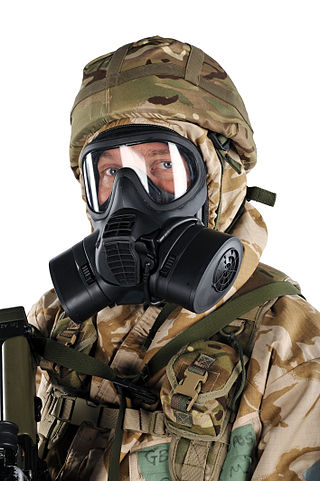
The General Service Respirator (GSR) is a military gas mask designed to replace the previous S10 respirator for the British Armed Forces. It was designed by the Defence Science and Technology Laboratory and Scott Safety in collaboration with the Ministry of Defence, and was manufactured by Scott Safety. Avon Protection now manufactures the GSR from its factory in Melksham after winning the in-service support contract in 2019.

The FM12 CBRN Respirator is a military gas mask produced by Avon Rubber.
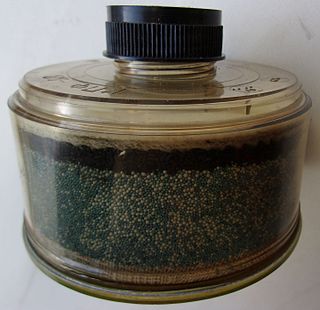
A respirator cartridge or canister is a type of filter that removes gases, volatile organic compounds (VOCs), and other vapors from air through adsorption, absorption, or chemisorption. It is one of two basic types of filters used by air-purifying respirators. The other is a mechanical filter, which removes only particulates. Hybrid filters combine the two.

A powered air-purifying respirator (PAPR) is a type of respirator used to safeguard workers against contaminated air. PAPRs consist of a headgear-and-fan assembly that takes ambient air contaminated with one or more type of pollutant or pathogen, actively removes (filters) a sufficient proportion of these hazards, and then delivers the clean air to the user's face or mouth and nose. They have a higher assigned protection factor than filtering facepiece respirators such as N95 masks. PAPRs are sometimes called positive-pressure masks, blower units, or just blowers.
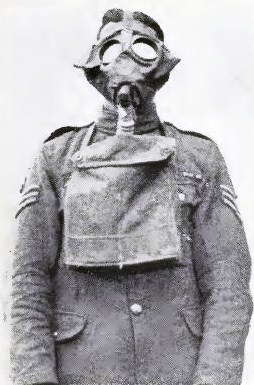
The Small Box Respirator (SBC) was a British gas mask of the First World War and a successor to the Large Box Respirator. In late 1916, the respirator was introduced by the British with the aim to provide reliable protection against chlorine and phosgene gases. The respirator offered a first line of defence against these. The use of mustard gas, was begun by the Germans; a vesicant ("blister agent") that burnt the skin of individuals that were exposed to it. Death rates were high with exposure to both the mixed phosgene, chlorine and mustard gas, however with soldiers having readily available access to the small box respirator, death rates had lowered significantly. Light and reasonably fitting, the respirator was a key piece of equipment to protect soldiers on the battlefield.
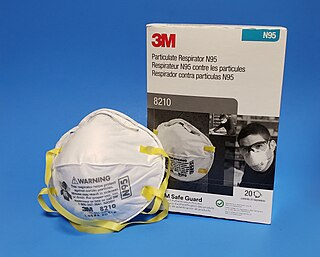
An N95 respirator is a particulate-filtering facepiece respirator or elastomeric filter that meets the U.S. National Institute for Occupational Safety and Health (NIOSH) N95 classification of air filtration, meaning that it filters at least 95% of airborne particles that have a mass median aerodynamic diameter of 0.3 micrometers under 42 CFR Part 84. This standard does not require that the respirator be resistant to oil; two other standards, R95 and P95, add that requirement. The N95 type is the most common particulate-filtering facepiece respirator. It is an example of a mechanical filter respirator, which provides protection against particulates but not against gases or vapors. An authentic N95 respirator is marked with the text "NIOSH" or the NIOSH logo, the filter class ("N95"), and, for filtering facepiece respirators, a "TC" approval number of the form XXX-XXXX, the approval number. All N95 respirators, regardless of type, must be listed on the NIOSH Certified Equipment List (CEL) or the NIOSH Trusted-Source page, and it must have headbands instead of ear loops.

Mechanical filters are a class of filter for air-purifying respirators that mechanically stops particulates from reaching the wearer's nose and mouth. They come in multiple physical forms.
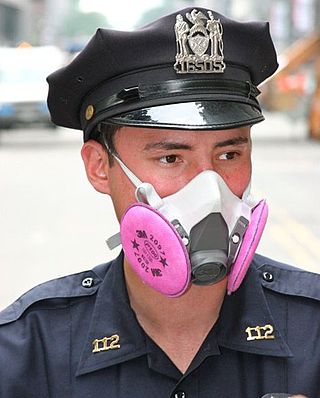
Elastomeric respirators, also called reusable air-purifying respirators, seal to the face with elastomeric material, which may be a natural or synthetic rubber. They are generally reusable. Full-face versions of elastomeric respirators seal better and protect the eyes.



















